Paula Modersohn-Becker with Elsbeth, c. 1903
Dear Friends,
Three great women artists are on view right now in New York, but the clock is ticking. Please make plans to take advantage of this superb simultaneous presentation of these excellent early 20th century modernists whose lives were as remarkable as their art:
Paula Modersohn-Becker, Neue Galerie, 86th and Fifth Avenue, NYC, through September 9, 2024. PMB specialist Professor Emerita Diane Radycki on Thursday, June 27th at 6:30 pm. Tickets.
Sonia Delaunay: Living Art, Bard Graduate Center, 38 West 86th Street, NYC, through July 7, 2024. (only 15 more days).
Käthe Kollwitz, Museum of Modern Art, 11 West 53rd Street, NYC, through Saturday, July 20th for general audiences; Sunday, July 21st for members only.
Paula Modersohn-Becker
Today's blog post is dedicated to Paula Modersohn-Becker. It's an edited version of my 2016 review of the PMB retrospective in Paris, originally published in Bonjour Paris. (Full access by subscription).)
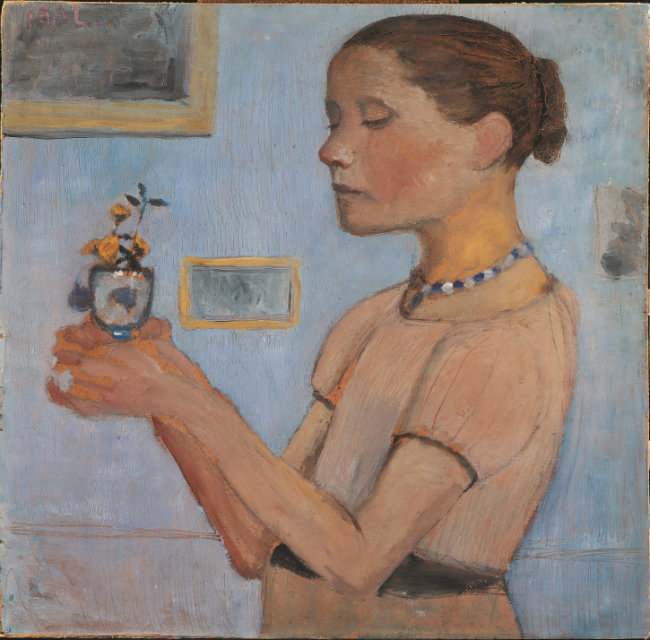
Paula Modersohn-Becker, Girl Holding a Glass with Yellow Flowers, 1902, distemper on cardboard, 52 x 53 cm, Bremen, Kunsthalle Bremen-Der Kunstverein in Bremen, © Paula-Modersohn-Becker-Stiftung, Bremen.
Paula Modersohn-Becker (1876-1907) lived like a modern heroine in a feminist film about self-determination and self-actualization. She studied art in various schools in her native Germany and in Paris. Born on February 8, 1876 in Dresden to the son of a university professor and daughter of a minor aristocrat, she moved with her family to Bremen in 1888 because of her father’s job with the railroad. Her father’s half-sister in London introduced her to art and arranged for lessons there. Upon Paula’s return to Bremen she enrolled in a teacher training program to satisfy her parents’ pragmatism. She also arranged for private art lessons on the side. This lasted from 1893 to 1895. In 1896, she moved to Berlin to study at the Association of Women Artists and in 1897, she moved into an artists’ colony in Worpswede, northeast of Bremen, where she met her future husband, the painter Otto Modersohn.
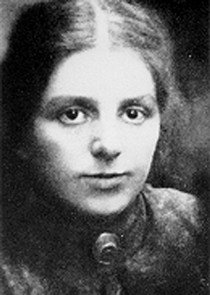
Photo of Paula Modersohn-Becker, 1904.
On New Year’s Day 1900, Paula and her closest friend in Worpsweder the sculptor Clara Westhoff set out for Paris to study art. Paula attended the Académie Colarossi, which accepted women, and anatomy lessons at the École des Beaux-Arts. She returned to Worpsweder in June. The following September, German-Czech poet Maria-Reiner Rilke joined the artists’ colony group. On April 28, 1901 he married Clara Westhoff and on May 25th, Paula married Otto. She also became a stepmother to Elsbeth, Otto’s daughter by his first wife, who died in 1900. The Rilkes had a daughter Ruth on December 12th and moved to Paris without Ruth in 1902. Paula would visit them and study art in 1903 and 1905, but eventually these short sojourns were not enough. On February 23, 1906, Paula left Otto to live permanently in Paris.
Paula Modersohn-Becker, Self-Portrait on Sixth Wedding Anniversary, 1906
Her goal was to become “something” in the art world, to find her own authenticity that might gain recognition among her peers. She often socialized with Clara and Rainer Maria Rilke in Paris and through them gained access to an exploding experimental art world. Another German couple, Lee and Bernard Hoetger, introduced her to various artists including Henri Rousseau in 1906 (according to Bernard’s recollections). Enchanted by Gauguin’s exotic primitivism, van Gogh’s colorful expressionism, and the Louvre’s masterpieces, from Egyptian Fayum funerary portraits c. 100 BC-300 AD to J.A.D. Ingres’ somewhat mannered Mademoiselle Rivière of 1806, she discovered ample resources to guide her anti-classical approach to contemporary subjects.
She tried to make a go of living as an independent artists from 1906 to 1907, but returned to her husband in the spring, pregnant from his visit in Paris earlier that year. She died on November 20th, after giving birth to her daughter Mathilde on November 2nd.
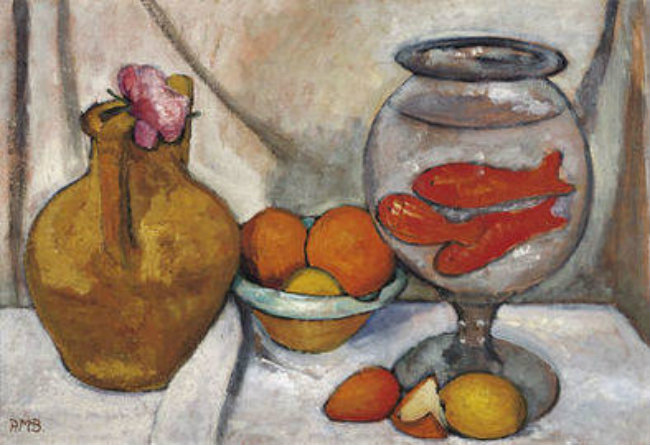
Paula Modersohn-Becker, Still Life with Gold Fish Bowl, May-June 1906, distemper on cardboard, 50.5 x 74 cm, Von der Heydt-Museum, Wuppertal, © Paula-Modersohn-Becker-Stiftung, Bremen.
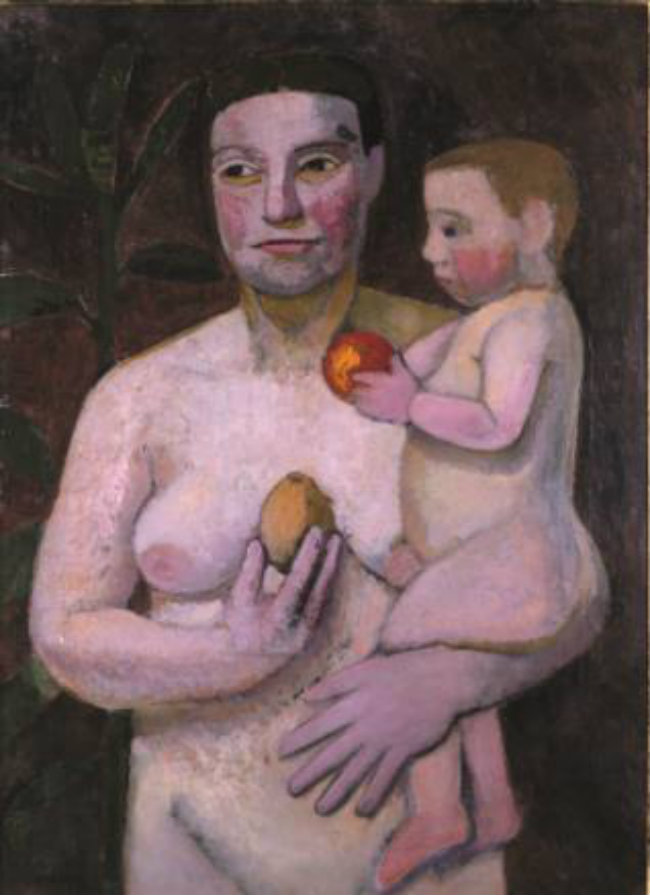
Paula Modersohn-Becker, Nude Mother and Child in Her Arms, Autumn 1906, distemper on canvas, 80 x 59 cm, Museum Ostwall im Dortmunder U, Dortmund, © Museum Ostwall im Dortmunder U, Dortmund .
In her compelling book Paula Modersohn-Becker: The First Modern Woman Artist (Yale, 2013), art historian Diane Radycki points out the unprecedented modernism of Modersohn-Becker’s women, especially nude mothers who exude an authentic naturalness that male artists had not achieved heretofore. Modersohn-Becker’s retrospective in Paris gives us an opportunity to examine her uniquely modernist approach to the maternal nude and her modernist preference for a medium that contributed further to an unidealized female figure. Her choice of distemper paint, a water-based recipe that mixes chalk and pigment with an animal glue or milk-based casein, produces a rough, pasty texture, as if a liquid base were thickened with fine sand. The effect in Modersohn-Becker’s work adds a rustic quality to the image, contrasting quite starkly with the polished refined surface of an academic painting and the contemporary primitivist Henri Rousseau, who strove to achieve a similar linear clarity with his oils. Modersohn-Becker, on the other hand, chose oil far less often and that choice seems quite deliberate.
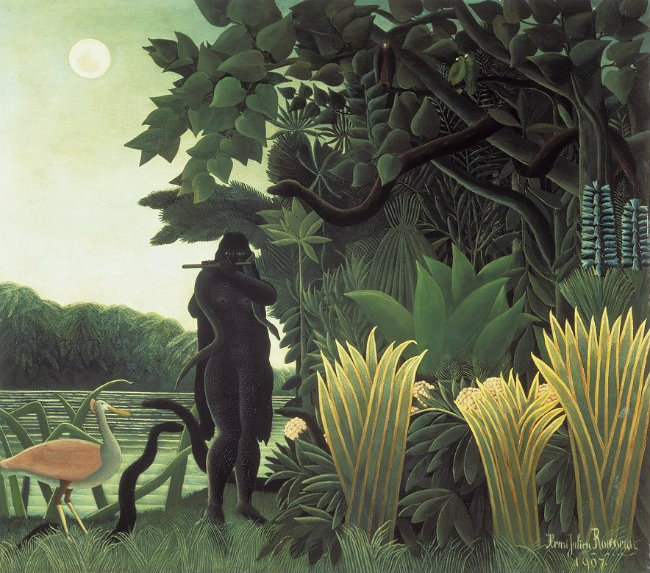
Henri Rousseau, Snake Charmer, 1907, oil on canvas, 167 x 189.5 cm Paris, Musée d’Orsay © RMN-Grand Palais (musée d’Orsay) / Hervé Lewandowski.
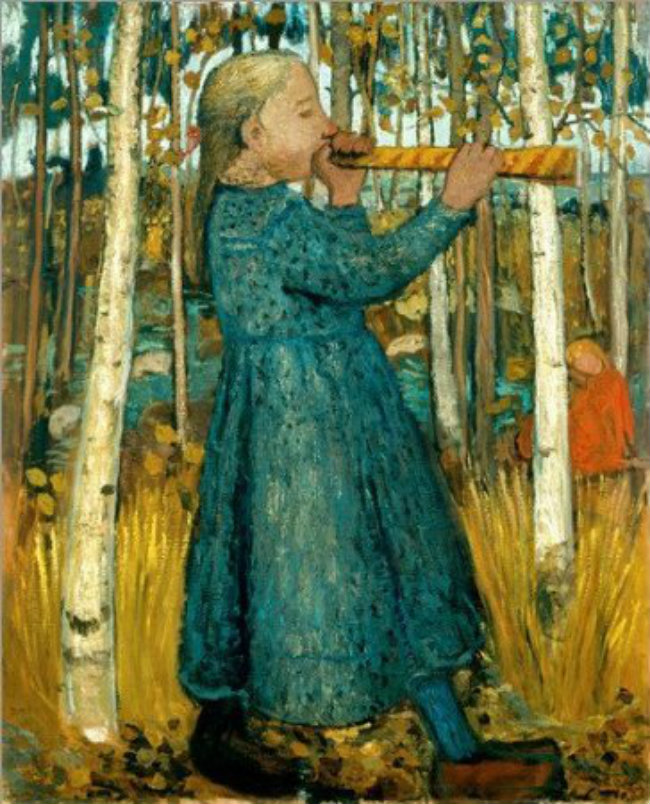
Right: Paula Modersohn-Becker, Girl Playing a Flute in the Forest of Birch Trees, 1905, distress on canvas on wood, 110.4 x 90.2 cm, Museen Böttcherstrasse, Paula Modersohn-Becker Museum, Brême © Paula-Modersohn-Becker-Stiftung, Bremen.
Modersohn-Becker’s decision to live and study art in Paris transformed her native talent into an original approach to modernism. Radycki claims this made her the “first modern woman artist” in art history. She benefited from a dynamic period of growth among young avant-garde artists, male and female. Two other important female modernists' retrospectives join hers in New York this summer. We are fortunate to have this opportunity to compare these three highly accomplished artists and savor their significant contributions to modern art.
Warm wishes from a very hot NY,
Beth
Beth S. Gersh-Nesic, PhD
Director/owner, New York Arts Exchange, LLC
Staff writer, Bonjour Paris





No comments:
Post a Comment